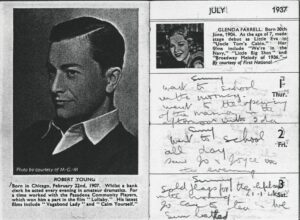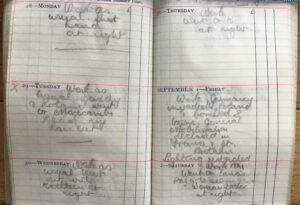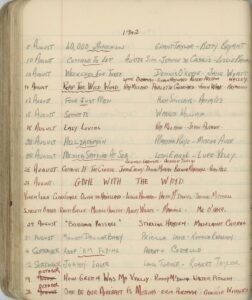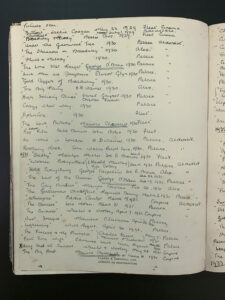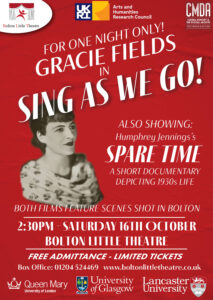Annette Kuhn discusses personal records of cinema visits
The Cinema Memory Archive (CMA) holds a number of written personal records of cinema visits made and films seen during the 1930s and after. These range in format from simple lists of film titles and/or favourite films and stars through to everyday activities diligently logged over weeks, months and years, the latter typically recording trips to the pictures alongside other events and activities in the chronicler’s daily life. There are variations, too, in the records’ closeness in time and place to the incidents they reference, the key distinction being records made ‘on the pulse’ (at, or very close to, the time they took place) as against those recollected some time—years perhaps, even decades—afterwards. Between the immediate and the recollected-at-a-distance there are hybrid records of various kinds, accounts that in different degrees embody both the immediacy of the very recent and the distance of the remembered experience.
The particular value of the immediate, ‘on the pulse’, type of account is that it can offer insight into the lived experience of cinemagoing and sometimes also convey a feeling for cinema’s place in the chronicler’s daily life. This is not, however, to downplay the value of the post facto record, whose cultural significance lies in its very qualities as a production of memory, a memory text. Chronicles of picturegoing in the Cinema Memory Archive include, in descending order of immediacy and detail: ‘on the pulse’ chronicles; ‘on the pulse’ list-making; repurposed chronicles; re-used and reframed lists; and listings composed from memory.
- ‘On the pulse’ chronicles: Jean Gowing and Kathleen Southworth
CMA holds details of diaries compiled during the 1930s by two young women who regularly recorded their daily activities: these included going to the cinema. Throughout 1937, Jean Gowing (born in East Anglia in 1919) kept a “Film-Fans” pocket diary [JG-96-003PW002] in which she set down a daily record of her activities, logging inter alia forty-nine trips to the cinema in the course of the year.
A page from Jean Gowing’s 1937 diary [JG-96-003PW002]
Each entry in the diary opens with a concise weather report (“Dull”; “Quite sunny”, etc) then briefly records the activities of the morning and/or the afternoon, with occasional mentions of evening activities. In logging her picturegoing Miss Gowing does not mention titles of films nor names of cinemas but invariably notes who accompanied her to the cinema:
“Sunny. Sold flags in the morning and [sea] bathed with [friend] Ida. Went to Ida’s for tea and we played tennis and went to the pictures” (Friday 16 July).
The Archive also holds a written record by Miss Gowing of several hundred films that she saw, along with the dates they were seen and sometimes the names of their stars, during the second half of the 1930s (discussed below), which suggests that she had also kept a separate and more extensive cinemagoing log.
*
Kathleen Southworth (born in Bolton, Greater Manchester, in 1921) started keeping a record of her daily activities at the age of ten. In 2022 CMDA was loaned Miss Southworth’s pocket diaries for the years 1932, 1933, 1934, 1937, 1938, and 1939 and a transcript of some of the diary entries was made for the Cinema Memory Archive [KS-22-004PW001]. In recording her habitual Saturday afternoon and frequent weeknight trips to the cinema, Miss Southworth consistently names—alongside the films she saw–the stars, the cinemas visited, and her cinemagoing companions (family members in the earlier years, female friends as she grew up). While the record is focussed in the main on her activities at school, at work, at home and at leisure, there are occasional allusions to events in the wider world: “Work. Went into town at night. Was fitted with gas mask” (21 June 1938); “Work. Germany invaded Poland and bombed 8 towns. General Mobilisation declared in France and Gt. Britain. Lighting restricted” (1 September 1939).
Kathleen Southworth records the prelude to World War 2 [KS-22-004]. On the following evening she went to the pictures with her friend Edna.
- ‘On the pulse’ list-making: Margaret Young (nee Stevenson) and Anonymous
In 1939, at the age of fourteen, Margaret Stevenson (born in Glasgow in 1925) began listing the films she had seen in a notebook in which she had previously been keeping track of exclusively school-related matters such as subjects taken, test results, and names of classmates [MY-92-001MM001]. Alongside film titles, her tabulated picturegoing records include dates of cinema visits and names of stars (PEOPLE). There are also separate lists of favourite film personalities (MY FILM STARS UNDER 20). The filmgoing record is maintained until September 1944, with a colour-coded rating scheme used throughout: one of her film favourites was Gone With the Wind, which she went to see more than once.
A page from Margaret Stevenson’s notebook [MY-92-001MM001]
*
In 2020, CMDA acquired a Daily Express Film Book dating from 1935, a large-format, profusely illustrated popular publication aimed at film fans. Purchased from an internet auction site for use as a stimulant in writing workshops, the book contains handwritten listings of “Pictures seen” between 1929 and 1976 at cinemas in several towns around the Surrey/Hampshire border in the South of England. Nothing is known about the compiler or compilers of the lists, which cover twelve pages and include names and locations of cinemas as well as film titles and varyingly precise dates of cinema visits [SN-20-002PW001]. Given that the book was published in the mid 1930s, the lists for the earlier years must have been compiled retrospectively, the degree of detail here suggesting that the chronicler had access to a pre-existing record.
The earliest listings by Anonymous in the Daily Express Film Book [SN-20-002PW001]
- ‘On the pulse’ and repurposed: Norman MacDonald’s ‘My Kind of Thirties’
In the mid 1980s, Norman MacDonald (born in Glasgow in 1915) wrote up (likely in edited form) entries in journals that he had kept during the 1930s, producing a substantial handwritten document that he called ‘My Kind of Thirties’ and which he dedicated to the memory of his late wife, Molly [NM-92-005PW002]. The Cinema Memory Archive holds photocopies of pages of ‘My Kind of Thirties’ containing most of the entries for the years 1935 and 1936, at which time Mr MacDonald was studying Law at the University of Glasgow and courting Molly. A keen cinemagoer in these years, Mr MacDonald records regular visits to the pictures–on his own, with University friends, with Molly–alongside chronicles of his daily activities. The entry for Saturday 12 January 1935, for example, reads:
“Busy morning in office. Fine dry and frosty day. Met Molly at 5.30 p.m. Had tea in Craig’s then went to see “Treasure Island” which we greatly enjoyed. Afterwards walked about town and had a look at several Print Shops. Coffee in the Royal (Spanish Room) then Molly got 10.30 p.m. train [home] to Lenzie. Invitation to Lenzie on Saturday.”
- Re-use and reframing: Jean Gowing and Norman MacDonald
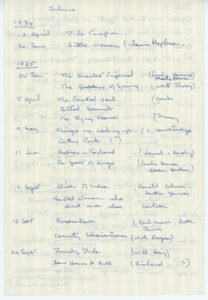
A page from Jean Gowing’s film list [JG-96-003PW001]
Jean Gowing, whose 1937 diary is discussed above, gave the Archive a listing of films that she saw between April 1934 and December 1939, a record that suggests she watched some three hundred pictures across those years–around fifty per year on average [JG-96-003PW001]. With precise dates throughout, Miss Gowing’s list bears hallmarks of an ‘on-the-pulse’ record. At the same time, its format and presentation—it is handwritten in a consistent style across eighteen identical sheets of new-looking letter-writing stationery–suggest that it was compiled expressly for Cinema Culture in 1930s Britain from a ‘primary’ document or documents, with selection probably constituting the principal, if not the only, form of editorialising.
In the early 1990s, Norman MacDonald attended a screening and discussion on popular cinema in the 1930s at Glasgow Film Theatre, where he completed a short questionnaire on the subject. He returned this along with a typewritten document headed ‘Going to the Flicks – 1935/36 Style’ which names eighty-eight films he had seen during those two years [NM-92-005PW001]. The details, evidently extracted from his journal ‘My Kind of Thirties’ (discussed above) in response to the questionnaire, include the year and the month in which he had seen each film, along with the film’s title and in some instances the name of the cinema where it was shown as well. While the bulk of the detail in this document ultimately derives from ‘primary’ records—a journal that was written in the 1930s and/or its 1980s edit–the distances of time (respectively sixty years and ten years) between the 1990s document and its sources have clearly opened up space for recollection, reflection, and reframing.

26 November 1936: ‘My Kind of Thirties’ [written in 1984]

November 1936: ‘Going to the Flicks 1935/1936 style’ [written in 1992]
- Listings composed from memory: Iris Alder and David Moore
The Cinema Memory Archive holds a number of listings composed from memory. Particularly extensive is that received from Iris Alder (born in Hampshire in 1924), who took part in CCINTB’s 1995 postal questionnaire survey. To her completed questionnaire she attached two large sheets of paper densely packed with names of film stars of the thirties, separated into “English” and “American” and adding up to around 120 in total, along with a separate inventory of 1930s films [IA-95-079PW001]. While on holiday that year Mrs Alder had spent time delving into her memory bank, rather surprising herself with the results: “Strange how all these names come to mind after 50+ years!”
*
Prompted by reminders or recollections of 1930s films and stars, list-writers sometimes add extra details. From my initial research into cinema culture in the 1930s there emerged a list of films that were particularly popular with audiences in Britain at the time: one Hollywood film and one British film for each year of the decade.[1] When David (J.D.D.) Moore (born in Hampshire in 1917) saw the list in 1991 it triggered memories of his own cinemagoing as a young Naval officer, and he was inspired to put together a document itemizing and commenting on some of the films that he saw [DM-92-034MI001]. In it he highlights how he and his peers felt about films at the time, and here and there he adds illuminating background details.
“(1938) I was in the destroyer EXMOUTH at Dover to escort the King and Queen en route to state visit in Paris, part of efforts to cement Anglo-French alliance. All the wardroom went ashore to see SNOW WHITE and loved it, quite amazing breakthrough in cartoons.”
The particular value of David’s “random thoughts”, he suggests in his covering letter, is that “they represent genuine 1st-hand memories of one who was there” [DM-92-034PL001].

David Moore recalls seeing ‘foreign’ films [DM-92-034MI001]
At this point, informants’ records of cinema visits made and films seen during the 1930s begin to shade into longer and more detailed personal accounts in the form of letters and essays composed from memory. The Cinema Memory Archive holds a number of these “memory work creations”. These will form the topic of another blog.
Digitised versions of most of the items discussed above can be accessed via the CMDA website. Many of them are also available to view in physical form in Lancaster University library: this can be arranged by getting in touch with Special Collections.
If you wish to cite and/or re-use any of these materials, please consult the CMDA website for information on copyright and using the materials from the collection and for a citation referencing guide
[1] The list appears in Annette Kuhn, An Everyday Magic: Cinema and Cultural Memory. London: I.B. Tauris, 2002. See page 252, Table 14.
